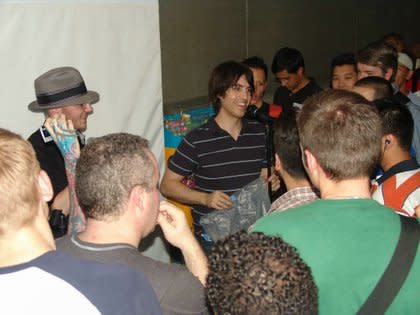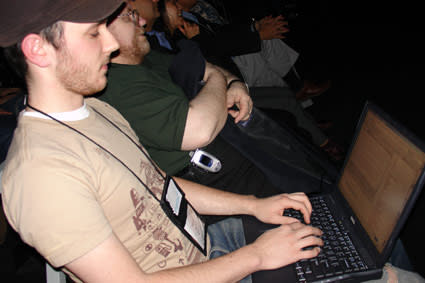Engadget has been testing and reviewing consumer tech since 2004. Our stories may include affiliate links; if you buy something through a link, we may earn a commission. Read more about how we evaluate products.
10 Years In: The birth of Engadget

The evening of June 23, 2005, wasn't especially hot in New York City, at least by historical standards. The day's high was a mere 79 degrees, slightly below average for late June, and well below the record for the day of 96. But inside Compact-Impact, a Japanese gadget store on the city's Lower East Side, things were downright steamy. As more than 200 sweaty fans packed the tiny storefront, it quickly became stifling, crowded and noisy. It wasn't an appearance by a hot local band or political activist. It was a meetup. For a blog. Engadget had arrived.
"I didn't know if anyone would come," recalled founder Peter Rojas. "The fact that people would show up and hang out with the guys from a gadget site kind of blew my mind."

Just 18 months earlier, Engadget was only a concept. Rojas had been running Gizmodo, the first blog launched by Gawker Media, since 2002, and saw how the emerging medium could shake up tech journalism.

Brian Alvey: I had already started designing Engadget when Peter asked us if he could hire a freelance designer he knew named Jill Fehrenbacher. She made pretty much the logo you see today, with the energy waves emanating from the "t" in Engadget. ... Over the years, Engadget fans have submitted photos from airports or marketplaces all over the world where electronics stores have ripped off that Engadget logo.
According to Rojas, Gawker's original model was to have single bloggers working part-time, but he saw potential for something bigger. So, in early 2004, he began talking to potential partners about launching a new gadget blog.
"I was nervous," Rojas said. "Back in the early days of blogging, there was this idea that there may only ever be one blog for each topic. A blog about New York. A blog about sports. There was a gadget blog. People posted at the time, 'I'm not sure we need another gadget blog.'"
With that in mind, he began planning his new venture, researching a range of potential partners, including CNET.
"I knew one of the founders, and I called and left him a voicemail. He never returned my call," Rojas said.
Jason Calacanis and Brian Alvey, who had recently gone into competition with Nick Denton's Gawker with their own blog network, Weblogs Inc. (WIN), also believed the world was ready for another gadget blog, and had already reached out to Rojas. They clicked, and on March 2, 2004, the team rolled out Engadget, which quickly became the flagship of the network.
"Early on we could tell from the traffic that it was going to be a success," recalled Alvey. "Engadget itself was never less than 20 percent of our entire network's traffic and it was often more than half. That ratio changed as we quickly launched new consumer-friendly sites like Autoblog, Blogging Baby, Luxist, Gadling and Joystiq, but they were all modeled after Engadget."
Calacanis, a serial entrepreneur who currently runs the successful LAUNCH event series, took heat for "poaching" Rojas from Gawker, but argued at the time that the new site would only help the nascent blogging industry.
"The bottom line is Nick is going to be wildly successful with his gaggle of blogs, and I think WIN and Engadget will be wildly successful," Calacanis wrote. "Nothing would please me more than to see Denton get rewarded for all his hard work with Gawker Media, and if he is successful, that means that blogging is legit (as we all know), and that is a good thing for me, Brian and Peter (and probably you too if you're a blogger)."
Rojas quickly established an editorial approach based on knowing — and respecting — the site's readers.
"What I loved about blogging was you could zero in on an audience that was passionate about gadgets," he said. "You didn't have to justify why you were writing about them. And we always tried to write up, not down — we didn't have to dumb things down. If you respect your readers' intelligence, they'll give you respect back. Our readers appreciated the fact that we didn't assume they were dumb or didn't know anything about tech. My assumption is that, if you're reading this, you know about tech, and you probably know more than we do."
At first, as at Gizmodo, Rojas was Engadget's only writer.
"I was a wreck," Rojas said. "I would sleep with my phone under my pillow and wake up in the middle of the night to check tips. If there was news in the middle of the night, there was nobody but me to do it."
Of course, the goal from the beginning had been to build a strong editorial team.
"We didn't have bylines at first," Rojas said. "In part because I didn't want people to see it was just one guy. But I also didn't want it to be about me. This wasn't Peter Rojas' LiveJournal. I wanted it to be a team thing."
That team began to take shape within a few months of the site's launch, with additions like Rojas' eventual successor, Ryan Block.
"Not long after Peter started Engadget, I dropped a line about a story he'd written, and almost out of nowhere he asked if I'd like to try my hand writing about technology," Block recalled. "And that right there is the thing about Peter: He's the guy who can draw connections that other people can't. I'd always loved technology, and I'd gone to school for writing — but he was the one who connected the dots."
By the end of 2004, the site had more than a dozen contributors, including veteran tech industry analyst Ross Rubin, whose Switched On column debuted in October, and continues on the site to this day. "As with many things in Engadget's early days, the path was paved by Peter Rojas, with whom I had had lunch in part to discuss this crazy new 'blogging' fad," Rubin said. "I had been editing a site about wireless technology for a major trade publisher and Peter had been kind enough to link to a few of my columns there. When he started Engadget, he reached out and said he'd love to have me contribute a column."
Another early contributor was Joshua Fruhlinger, who would later become the site's editorial director. "I met Peter Rojas and Ryan Block down at TeaNY in the Lower East Side to talk about a potential writing job for Engadget. ... We nerded out for a bit and they quickly offered me a contributing editor job at a whopping $800/month. I had to file 200 stories every 30 days, which sounds like a lot, but I figured that only came to about seven stories a day. I could do that on my lunch break while I was working at Razorfish. And I did."
With a team in place, the site became more ambitious, sending writers to major industry events like CES, interviewing industry leaders and reviewing products.
"When we first did CES in 2005, we were woefully understaffed," Rojas said. "But it helped put us on the map. Nobody was liveblogging the press conferences. We changed the metabolism of tech news. We made it faster, and it also meant a lot of products that didn't get attention before were able to get attention. We'd write about the smaller companies and products that couldn't reach the mainstream tech media."

As Block recalled, "We didn't know it at the time, but we were helping write the new rulebook for media. It's easy to take for granted now, but at the time, the only media taken seriously was printed on dead trees, and was, at best, half a day old or more. And there we were, chronicling the rise of all these disruptive new technologies, not even fully aware of just how disruptive a force we were about to become in technology media."
The site continued to grow, as did its influence. Dozens of other tech blogs were launched, and Engadget became something of a hub for that growing universe. "The whole point of a blog, initially, was to link to the best of what's out there," Rojas said. "Blogging meant the democratization of media; anyone could set up shop and have their voice. We wanted to be part of that world."
By 2005, Engadget had caught the attention of industry insiders like Michael Gartenberg, then of Jupiter Research, who commented (in a blog post, of course): "Several vendors have told me recently that they're not overly concerned with what Walt Mossberg says about them anymore. They're concerned about what Peter Rojas is saying about them on Engadget and what he's telling his audience both online and offline." The site also caught the attention of AOL, which acquired it — along with the rest of the Weblogs Inc. network — in late 2005.
When Engadget was sold to AOL, Rojas stayed on for two years, working with Block, who became the site's second editor-in-chief, to make sure that the new owners didn't dilute its impact or try to change its focus. He later returned to AOL, after the company acquired another startup, gdgt, which has since been merged into Engadget. While the site has grown and changed over the past decade, he still sees today's Engadget as a strong continuation of everything he did in those early days. "People ask, 'What's the trick?' The trick is to post stuff that's good and that people like. I'm super proud that the legacy continues. I can read a post on Engadget and it makes me feel smarter. The format is still there in terms of being witty and concise and knowledgeable."

